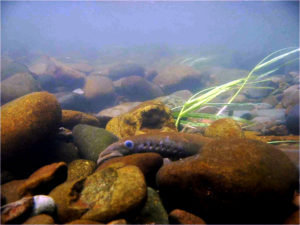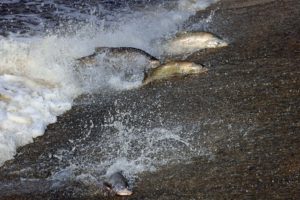California once supported an estimated 500,000 Coho salmon (Oncorhynchus kisutch). Today the total population is estimated at 5,000 fish and is unfortunately continuing to decline. However, if you’re in the right place at the right time, you can see some of the remaining fish return to spawn in their natal streams, generally after winter storms. Coho usually spawn in short, coastal drainages. In our area they can be found in Scott and Waddell creeks in Santa Cruz County and Lagunitas, Redwood, Pine Gulch, and Olema creeks in Marin County.
After about two years at sea, coho congregate in schools near the mouths of the streams where they were born, awaiting the clues that the stream is deep and cool enough for passage. Their sense of smell is very acute, and apparently they can discern the singular scent of their own birth stream.
After making her way upstream, the female finds a bed at the bottom of a chattering riffle where the gravel is fine, so she can sift it with sideways motions, making a shallow depression–a “redd”–in which to deposit her eggs. She repeats the process, moving upstream, and burying the eggs below with the gravel from the next redd.
The bright-red male, waiting in the shallows, follows her upstream and spreads his milt over the freshly laid eggs. When her cache of eggs and his reserves of milt are spent, the fish swim to the shallows or the shade of an undercut bank to die, providing nutrients to the stream and forest ecosystem. Once hatched, the coho fry remain in the stream for more than a year before they migrate to the ocean.

.jpg)



